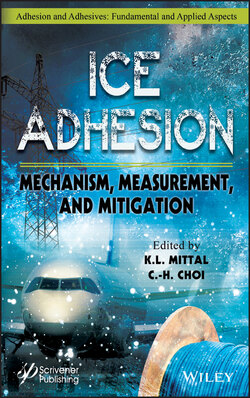Читать книгу Ice Adhesion - Группа авторов - Страница 52
3.4 Summary
ОглавлениеIn this chapter, fundamentals of ice formation on an icephobic substrate are discussed. Ice formation is divided into two steps: ice nucleation and ice growth. As a droplet is placed on a sub-zero surface, after ice nucleation delay time, the ice nucleolus forms by a process governed by thermodynamics of ice-water-surface system. Gibbs energy barrier is the parameter that determines ice nucleation temperature (Eq. 3.1), and depends on surface factor which can be tuned through manipulating surface geometry and surface free energy. Surface factor is obtained as a function of surface geometry and surface free energy for both convex and concave surfaces (Eqs. 3.7 and 3.9). Nucleation rate is defined for a droplet on the surface as a function of temperature and Gibbs energy barrier (Eq. 3.11). The second step in ice formation on a surface is ice growth. This step which is controlled by heat transfer is studied in two different cases. The first case is when there is no airflow around the droplet and the second one is in the presence of a highly convective external air flow. Theoretical models are developed for both these cases through energy and mass balance equations. In the first case, heat transfer mostly occurs through the solid substrate and the ice grows from solid-liquid interface. Ice growth rate is determined for different conductivities and thicknesses of substrates (Eqs. 3.26 and 3.27). In the second case, heat transfer mostly occurs through convection and the ice growth originates at air-liquid interface by the rate given in Eq. (3.40). Ice bridging is a phenomenon where an ice bridge is formed between a frozen droplet and its adjacent liquid droplet which leads to the freezing of the liquid droplet. The ice bridge growth rate is governed by vapor pressure gradient between a frozen and a liquid droplet where they show source-sink behavior for the vapor, Eq. (3.46).
